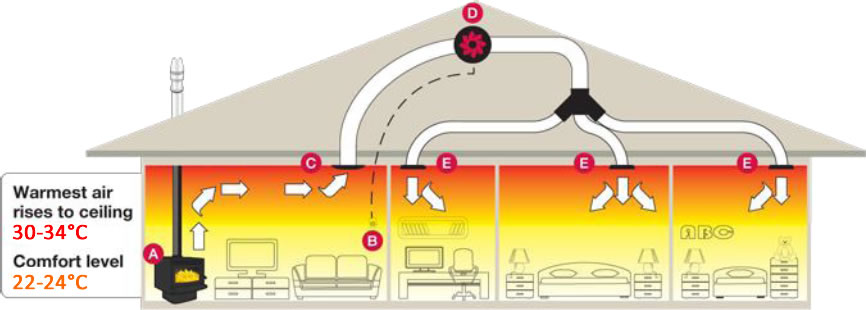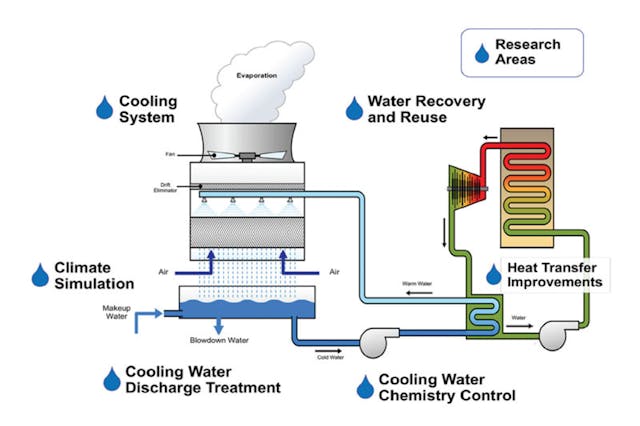The Duty of Heat Transfer Systems in Sustainable Energy Solutions for the Future
Heat transfer systems are essential in the mission for lasting power services. They optimize thermal power monitoring, boosting the efficiency of eco-friendly innovations. By utilizing mechanisms like conduction, radiation, and convection, these systems minimize energy losses. Their role in solar thermal and geothermal applications is particularly significant. As innovations emerge, the possibility for more improvements increases important inquiries concerning future energy strategies. What developments will shape the landscape of lasting energy?
Understanding Heat Transfer Systems

The Importance of Thermal Energy Administration
Efficient thermal energy administration is necessary for maximizing power effectiveness and lessening waste in various systems. By regulating temperature level and maximizing Heat transfer procedures, companies can significantly decrease energy usage and operational costs. Reliable monitoring includes the implementation of advanced technologies and methods that monitor and control thermal conditions within systems, making sure that energy resources are made use of efficiently. In enhancement, appropriate thermal power management contributes to minimizing greenhouse gas discharges, lining up with international sustainability objectives. It also boosts system reliability and efficiency, bring about improved product high quality and longer equipment life expectancy. Ultimately, focusing on thermal energy monitoring is a vital action in the direction of creating extra sustainable power remedies and fostering a liable method to power consumption in industrial and residential contexts.
Applications of Heat Transfer in Renewable Resource
While different sustainable power resources promise sustainability, the effective application of Heat transfer plays a necessary function in their effectiveness. In wind energy systems, Heat transfer is used for turbine component air conditioning, improving performance and longevity. Geothermal energy depends on reliable Heat exchange between the earth's subsurface and the liquid circulating in the system, making the most of power removal. Biomass power procedures likewise gain from Heat transfer, as it aids in transforming natural products right into usable gas via pyrolysis and gasification. Additionally, in hydropower, preserving suitable temperature levels in storage tanks can enhance power output. Each of these applications shows the critical significance of Heat transfer systems in boosting eco-friendly energy modern technologies, ultimately adding to a more sustainable energy future.
Enhancing Solar Thermal Power Performance
As solar thermal power systems continue to advance, boosting their performance has actually come to be necessary for making the most of energy output. Developments in Heat transfer innovations, such as enhanced thermal storage space materials and innovative Heat exchangers, play a substantial function in improving performance. By making use of innovative products that have superior thermal conductivity, systems can move and catch Heat a lot more effectively. Additionally, integrating radar that comply with the sun's path guarantees that collection agencies get ideal solar direct exposure throughout the day. Utilizing nanotechnology in solar absorbers can further boost power absorption rates. Furthermore, incorporating computerized control systems aids handle and control temperatures power circulation efficiently, resulting in decreased losses and improved total system effectiveness. These enhancements pave the method for more lasting solar thermal energy solutions in the future.
Geothermal Heating: A Sustainable Solution
Geothermal home heating presents a viable option for lasting power, using substantial ecological advantages with decreased greenhouse gas discharges. Its efficiency and cost-effectiveness make it an attractive option to typical heater. Obstacles associated to execution needs to be addressed to optimize its potential influence.
Environmental Advantages of Geothermal
Although conventional heating methods add substantially to greenhouse gas discharges, geothermal heating provides a compelling option that minimizes ecological influence. By using the Earth's inner Heat, geothermal systems make use of a renewable resource resource, markedly lowering dependence on fossil fuels. This method produces marginal carbon emissions, making it a cleaner choice for residential and industrial home heating. In addition, geothermal systems advertise power effectiveness, as they need much less power contrasted to standard heater. DVS Heat Transfer Systems. The use of geothermal power additionally aids in reducing air contamination, enhancing neighborhood air high quality and public health. As a sustainable solution, geothermal heating sustains environment adjustment reduction efforts, positioning itself as a necessary part in the change in the direction of a greener future
Effectiveness and Cost-Effectiveness
Just how does geothermal home heating gauge up in regards to efficiency and cost-effectiveness compared to traditional furnace? Geothermal home heating demonstrates premium performance, frequently achieving a coefficient of performance (POLICE OFFICER) of 3 to 5, implying it produces three to 5 devices of Heat for each unit of electricity eaten. This performance converts into lower operating expenses, specifically in areas with stable geothermal sources. Initial setup expenses can be more than conventional systems; nonetheless, long-lasting cost savings on energy costs and reduced maintenance expenditures can offset these in advance financial investments. In addition, lots of governments incentivize geothermal systems via rebates and tax obligation debts, boosting their cost-effectiveness. In general, geothermal home heating becomes a lasting and financially sensible alternative to even more standard heating solutions.
Application Challenges and Solutions
Many challenges can restrain the extensive application of geothermal heater, in spite of their clear benefits as a lasting power remedy. High preliminary setup expenses frequently discourage property owners and investors, making funding a considerable barrier. Additionally, the geographical limitations of suitable geothermal websites restrict ease of access in specific areas. Neighborhood policies and allowing processes can likewise make check my reference complex project advancement, causing delays. In addition, public recognition and understanding of geothermal systems continue to be low, impeding approval. To attend to these challenges, targeted education campaigns can improve public expertise, while federal government motivations could alleviate financial problems. Teaming up with neighborhood authorities to enhance laws might help with smoother project authorizations, ultimately promoting the fostering of geothermal home heating as a sensible, lasting power alternative.
Innovations in Heat Transfer Technologies
Advancements in Heat transfer technologies play a crucial function in improving power effectiveness and sustainability. Advanced Heat exchangers and phase change products go to the center of these growths, using significant enhancements in thermal management. These technologies not just maximize energy usage but also add to lowering ecological impact in numerous applications.
Advanced Heat Exchangers
Advanced Heat exchangers play a crucial duty in improving energy performance throughout various applications in lasting energy options. These devices help with the transfer of Heat in between 2 or even more liquids, substantially reducing energy usage in procedures such as commercial home heating, cooling, and power generation. Developments in products and style, such as using nanofluids and small configurations, have actually caused enhanced thermal efficiency and minimized size demands. Additionally, innovations in digital surveillance and control systems permit optimized operation, more enhancing efficiency. By reducing waste Heat and making the most of energy healing, progressed Heat exchangers add to decrease carbon footprints and support the change toward eco-friendly innovations. Their proceeded advancement is essential for achieving worldwide power sustainability objectives.
Stage Change Materials
The assimilation of phase change products (PCMs) into Heat transfer modern technologies stands for a considerable advancement in power administration and effectiveness. PCMs soak up and launch thermal energy during their phase adjustments, making it possible for effective temperature guideline in structure products and energy systems. By saving excess Heat throughout height durations and launching it when need increases, PCMs add to load changing and power conservation - DVS Heat Transfer Systems. This capability improves the efficiency of eco-friendly power systems, specifically in solar thermal applications. Additionally, PCMs can improve the thermal convenience of indoor environments, decreasing dependence on traditional heating and cooling techniques. As advancements in PCM formulas continue to emerge, their function in sustainable energy services is poised to grow, supplying encouraging methods for future research study and application

Future Potential Customers for Heat Transfer in Sustainable Energy
As the need for lasting power services remains to climb, the function of Heat transfer systems is ending up being significantly crucial in shaping future technologies. Innovations in products and layouts are expected to enhance effectiveness in Heat transfer, minimizing power losses in various applications. The integration of innovative thermal storage space systems, such as stage change products and thermochemical storage space, will certainly make it possible for far better management of power sources. Study right into nanofluids and biomimetic Heat exchangers might better enhance thermal efficiency. The adoption of clever modern technologies will enable for real-time monitoring and flexible control of Heat transfer processes. These innovations are positioned to substantially add to the total effectiveness and sustainability of energy systems, leading the way for a much more energy-efficient future.
Regularly Asked Concerns
How Can Individuals Apply Heat Transfer Equipment in the house?

People can execute Heat transfer systems at home by mounting energy-efficient devices, using radiant heating, and enhancing insulation. These procedures enhance energy efficiency, decrease prices, and advertise sustainable techniques in domestic atmospheres.

What Are the Prices Related To Setting Up Heat Transfer Equipments?
The prices associated with installing Heat transfer systems differ extensively, generally encompassing equipment, installation labor, and upkeep. Variables such as system kind, home size, and neighborhood regulations significantly affect the general expenditure included.
Exist Government Incentives for Heat Transfer System Installations?
Federal government incentives for Heat transfer system installations vary by region and can consist of tax obligation grants, discounts, and credit scores. These financial advantages aim to motivate adoption, ultimately advertising energy performance and minimizing environmental effect within areas.
Just How Do Heat Transfer Systems Effect Energy Expenses?
Heat transfer systems especially affect power bills by optimizing power performance. By improving the transfer of Heat, these systems lower power intake, bring about reduced utility expenses and producing a more lasting approach to power management.
What Maintenance Is Required for Heat Transfer Systems?
Maintenance for Heat transfer systems includes regular examinations, cleaning of elements, examining fluid degrees, making look here certain correct insulation, and replacing worn parts. These tasks help keep effectiveness, stop breakdowns, and lengthen the system's operational lifespan.
These systems help with the activity of thermal power from one tool to another, making it possible here are the findings for the transfer of Heat for home heating, power, or air conditioning generation functions. Geothermal energy relies on reliable Heat exchange between the earth's subsurface and the liquid flowing in the system, taking full advantage of energy extraction. Furthermore, geothermal systems promote power performance, as they need much less energy compared to standard heating systems. Advanced Heat exchangers play a necessary function in improving energy performance throughout various applications in lasting energy options. Heat transfer systems notably influence energy bills by enhancing energy efficiency.